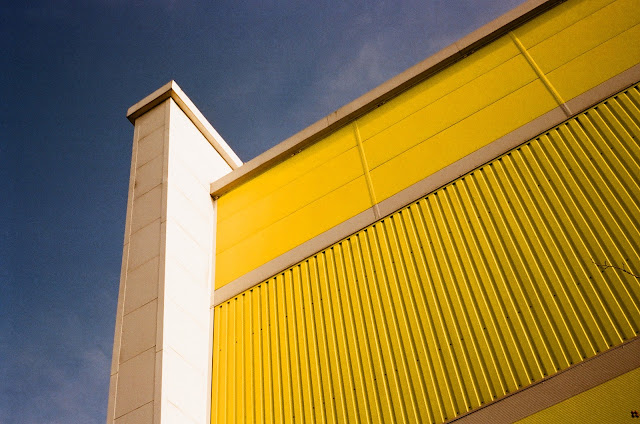Olympus Trip 35
"David Bailey. Who's he?" Anyone over a 'certain' age from the UK will remember that television advert. The Olympus Trip 35 was a small, cheapish camera that could be used by professionals because it had a Zuiko lens, "as used on the Olympus OM-1, one of the best cameras in the world". When I was shooting film in the eighties the Trip never appealed to me. I bought a Canon Sureshot instead. However while trawling through the local charity shops I came across an example for £10 and couldn't resist it.
The camera was in fairly good shape but did have a dent in the base plate where it had probably been dropped. A good test for the Trip is to cover the lens, therefore also covering the light meter, and depress the shutter button. If there isn't enough light a red indicator magically rises in the viewfinder. On my example this didn't happen immediately. After a few rapid depressions of the shutter release the red indicator did appear. I hoped it was just a bit sticky after years of non use. Anyway I handed over the £10 and took the Trip home.
A usual problem with old cameras is that the light seal material has decayed and turned into a black sticky mess. Fortunately with the trip the lights seals are only in place at the hinge end of the back. These were easy to clean up and replace with new seals. I cut the seals myself from self adhesive neoprene door insulation. This appears to work well enough.
In use the Trip is easy to carry around and fits nicely in the hand. It isn't very heavy (it doesn't need a battery) so I fitted a wrist strap only. My example came with a Skylight (1B) filter attached. On the Trip a filter doesn't cause an exposure issue as the meter is placed around the lens and so measures through the filter. A simple catch opens the back and film loading is fairly standard, if you're used to loading film cameras.
Once I had some film in the camera (Kodak Colorplus 200) I took the Trip out on my lunchtime walk from the office. Luckily for me this involves walking across a moor and along a canal, both reasonable sources for good shots. In use it was evident that the sticky shutter problem was still present. Before each shot it was necessary to 'loosen' up the shutter by depressing the shutter release rapidly a few times. This is a bit of a pain but something that I will see if I can correct.
The Trip sets the film ISO by rotating the silver ring on the front of the lens. This is easy to do and therefore it is easy to do inadvertently. I found I was constantly checking that the ISO setting had not changed.The Trip is fully automatic. The ring at the back of the lens is set to 'A' and the camera does the rest. It sets a shutter speed of either 1/40th or 1/200th of a second. It also selects an aperture between f2.8 and f22. The aperture can be set manually but this sets the shutter speed to 1/40th second and is intended for use with flash. The Trip using zone focussing with 5 settings but only 4 symbols on the lens.The symbols show mountains, complete figures, half figures and half a single fingure. These correspond to focusing distances of infinity, 3m, 1.5m and 1m. The focus will move one more stop round and although not indicated I have read that this is equal to 0.9m.
Film is advanced via a thumbwheel on the back of the camera. This has a positive feeling and works well enough. The view finder has bright guidelines for the framing. It also has parallax marks for framing when photographing close objects. The shutter release is positive and you know that you have taken a photo. If there isn't enough light the red warning pops up in the viewfinder and the shutter is locked. It's all fairly simple but it works rather well. The film counter on the top plate counts up. When the film is finished rewind is fairly standard. Depress the button the base plate and rewind using the crank on the top plate.
So what are the pictures like using the fabled Zuiko lens?
These are from the first roll of Kodak Colorplus 200.
And I must say I'm quite impressed. The exposure is spot on and the zone focusing has worked well. The into the light shot of the canal is a picture I've been trying to get for ages on digital cameras. The Trip has made the best effort yet. I reloaded the Trip with some Ilford XP2 400. This was the first time I had tried this film. Again I was impressed with the results.
So overall I'm very impressed with the camera and the results it produces. It would be an ideal camera for vacation. Unfortunately unless I can get the shutter issue resolved on my one I won't be using it for my holidays. However as Olympus made and sold so many of these cameras it is fairly easy to find them in charity shops or buy them at a reasonable price from Ebay. I'm going to keep my eye out for another one in perfect working order.
Postscript - February 2023
I have just found a Trip 35 in perfect working order in a charity shop for £6. So now I'm happy. Here are some shots from the new camera:
Cassiobury Park Trees - Kodak Tri-X
St Luke's church Watford - Kodak Tri-X
Cassiobury Park canal - Kodak Tri-X
Cassiobury Park Trees - Kodak Tri-X



















Comments
Post a Comment